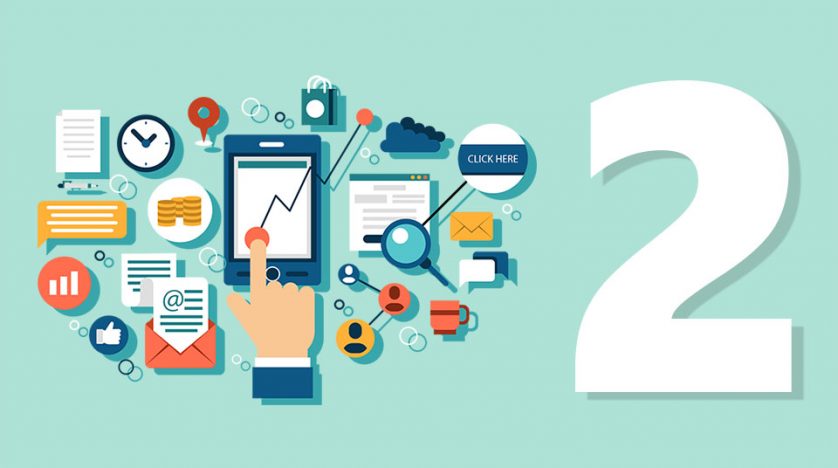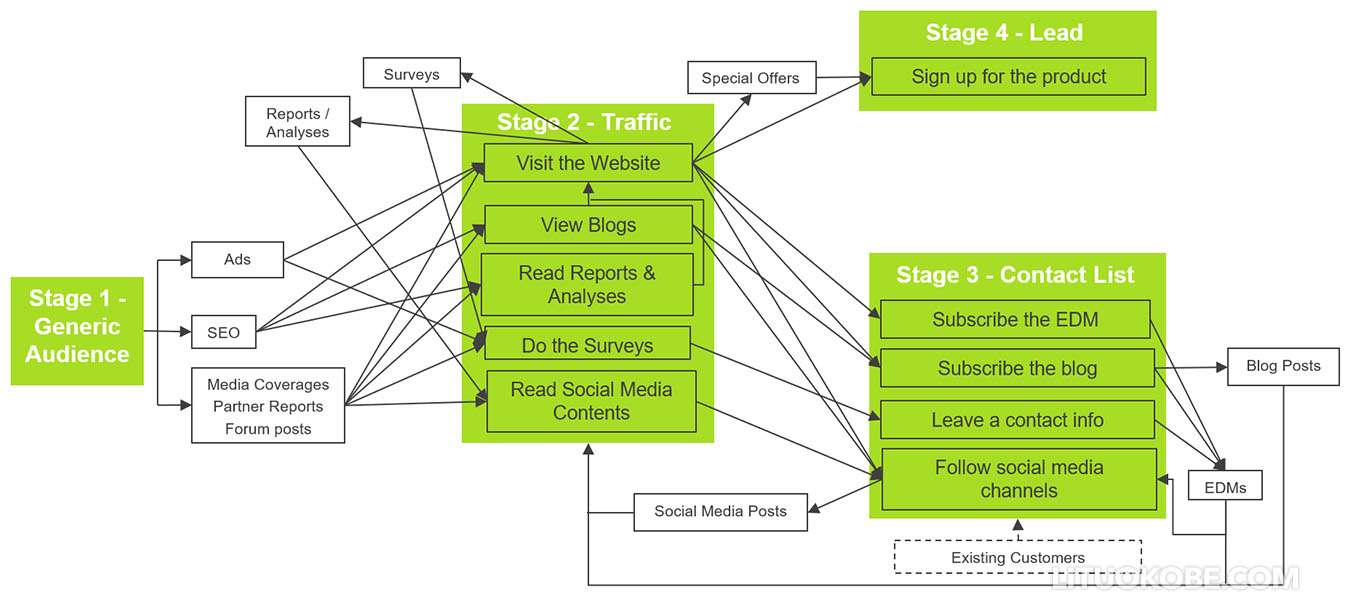
We have discussed the customer journey stages and the approaches to drive their behaviors. Let’s put them together, to see the full picture of the B2B digital marketing system.
4. The Full Picture of the Customer Journey Stages and the Approaches
In Figure 4, the 4 stages are marked with green, and the small boxes inside them are actions that customers take at the stage. The white boxes are approaches that drive the customers moving from one stage to another. You can also interpret the figure this way: the green boxes are customer-action-boxes, the white boxes are marketer-action-boxes.

Figure 4 – B2B Digital Marketing System Full Picture
OK, let’s start from the left side. As explained before, “Stage 1 – Generic Audience” is everyone that can access your marketing approaches. However, because these people haven’t had any connections with your online presences yet, the marketing information can only be exposed to them via 3 ways – Ads, SEO (organic searching results) and the content channel approaches (Media Coverage, Partner Reports, Forum Posts). Among these approaches, Ads and SEO are 2 important gateways to the owned channels.
Then, some of them become traffic that actually visits your marketing contents. To make it simple, I assume that all the conversions happen on the website (e.g. there is a conversion page on the site), that’s why only one customer-action-box, visit the website, will reach the “Stage 4 – Lead”.
So now, the mission becomes clear – to let as much as possible traffic visit the website conversion page. And this is where “Stage 3 – Contact List” plays a powerful role. As mentioned before, in 2B2 digital marketing, many customers are too rational to be directly converted, but they will consider your product as a candidate. Consequently, you, as a marketer, should aim to get their contact information and re-market the product to them whenever is necessary. As shown in Figure 4, the approaches can be inviting them to subscribe to your EDM or blog, or letting them follow your social media channels. As a result, they will have another chance to consider the product, when you post a blog, social media article, or send an EDM.
You may notice that 2 marketer-action-boxes are on the upper-left corner, starting from “Stage 2 – Traffic” and then pointing back – Publish a Survey and Publish Report & Analysis. These 2 approaches are popular, especially for products that provide professional benefits (e.g. SaaS). Because the customers’ original intention is to look for solutions with values, rather than to buy a product. Apparently, these 2 approaches are more “user-friendly” – the customer may be more interested into taking an industry survey than watching a hard-sell ad, and he/she could be more willing to read a free report or analysis to get some knowledge. Most importantly, by letting them do your surveys or reading your reports, you have a chance to get their contact information and add them to the contact list! This could be more fun if you combine the survey and report approaches, and I will explain this in detail in another article.
Another thing I want to mention is that, for Google Analytics users, this tool will insert a cookie into each website visitor’s browser, and this is how returning visitors are identified. Google Analytics stores a secret contact list which you can’t directly access. Only when your Google Analytics account is connected to your AdWords account can you use the list to do a re-marketing campaign. I feel reluctant to include this list as part of “Stage 3 – Contact List” since the control level is so low that you can’t use the list for a re-marketing project based on your own platforms.
The special offer part represents the company’s own campaigns, without leveraging the power from other parties. It could be a big driver for B2C companies. I will write another article to discuss this approach.
Last but not least, the content used by one approach can be or should be shared by certain other approaches. For example, you are planning a special offer on the website, and this information is supposed to be spread out via blogs, EDMs, and social media.
5. Conclusion
This is the system that provides the basic process for how the different digital marketing activities interact with each other and with the customers. It is a good starting point for you to plan your B2B digital marketing activities. And you can set up separate KPIs for different approaches in this system, like keywords organic ranking for SEO, CTR for CPC ads, or open rate for EDMs. Observe how the performance of one approach affects another and find out the bottleneck if possible. It’s always good to convert a complicated job into a visually organized system. I wish you all the best in your future digital marketing activities!